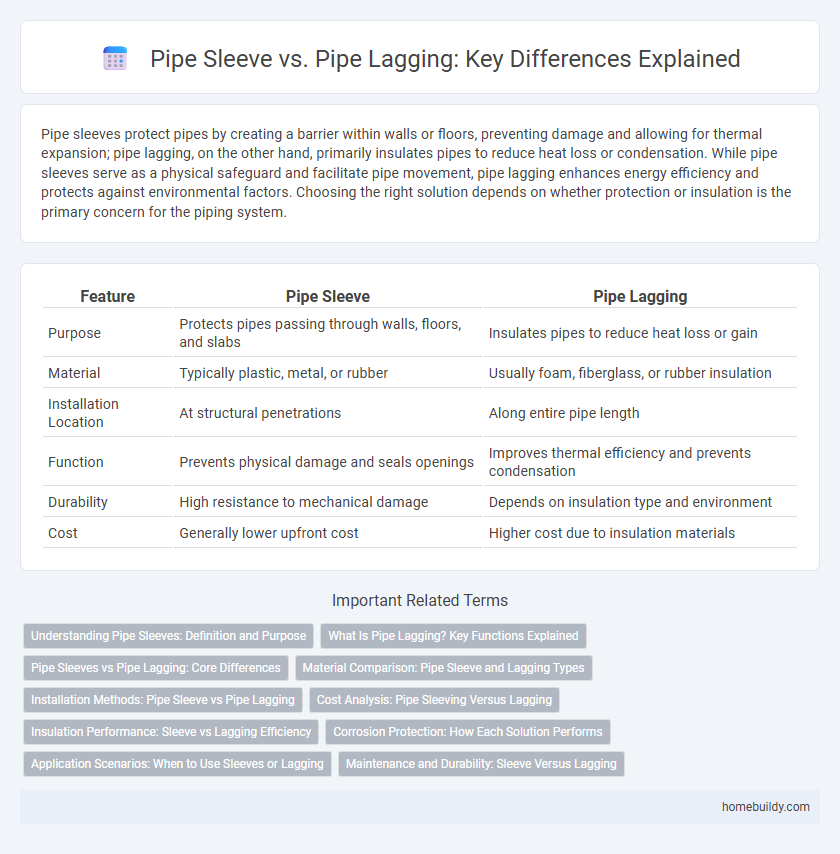Pipe sleeves protect pipes by creating a barrier within walls or floors, preventing damage and allowing for thermal expansion; pipe lagging, on the other hand, primarily insulates pipes to reduce heat loss or condensation. While pipe sleeves serve as a physical safeguard and facilitate pipe movement, pipe lagging enhances energy efficiency and protects against environmental factors. Choosing the right solution depends on whether protection or insulation is the primary concern for the piping system.
Table of Comparison
| Feature | Pipe Sleeve | Pipe Lagging |
|---|---|---|
| Purpose | Protects pipes passing through walls, floors, and slabs | Insulates pipes to reduce heat loss or gain |
| Material | Typically plastic, metal, or rubber | Usually foam, fiberglass, or rubber insulation |
| Installation Location | At structural penetrations | Along entire pipe length |
| Function | Prevents physical damage and seals openings | Improves thermal efficiency and prevents condensation |
| Durability | High resistance to mechanical damage | Depends on insulation type and environment |
| Cost | Generally lower upfront cost | Higher cost due to insulation materials |
Understanding Pipe Sleeves: Definition and Purpose
Pipe sleeves are protective casings installed around pipes to provide structural support and safeguard against external damage, corrosion, and movement. Unlike pipe lagging, which primarily focuses on insulation to maintain temperature and prevent condensation, pipe sleeves offer mechanical protection and facilitate easy pipe replacement or maintenance. Understanding the distinction highlights that pipe sleeves enhance durability and longevity in piping systems, while lagging ensures thermal efficiency.
What Is Pipe Lagging? Key Functions Explained
Pipe lagging is an insulating material wrapped around pipes to protect against heat loss, condensation, and external damage, enhancing energy efficiency in plumbing and HVAC systems. Unlike pipe sleeves, which are rigid protective tubes designed primarily for physical protection and easy pipe replacement, lagging focuses on thermal insulation to maintain temperature control. The key functions of pipe lagging include reducing heat transfer, preventing pipe freezing, and minimizing energy costs in both residential and industrial applications.
Pipe Sleeves vs Pipe Lagging: Core Differences
Pipe sleeves provide a protective barrier around pipes, preventing damage from external forces and facilitating easy pipe movement or replacement. In contrast, pipe lagging is primarily used for insulation, reducing heat loss and preventing condensation on pipes. The core difference lies in pipe sleeves being a physical protective casing, while pipe lagging focuses on thermal insulation and energy efficiency.
Material Comparison: Pipe Sleeve and Lagging Types
Pipe sleeves are typically made from metal, plastic, or rubber materials offering durability and protection against physical damage during pipe installation. Pipe lagging commonly consists of insulating materials such as fiberglass, foam, or mineral wool, designed to reduce heat loss and prevent condensation on pipes. While pipe sleeves provide structural protection, lagging materials focus primarily on thermal insulation and moisture control.
Installation Methods: Pipe Sleeve vs Pipe Lagging
Pipe sleeve installation involves embedding a protective casing within walls or floors to allow pipes to pass through while preventing damage and accommodating pipe movement. In contrast, pipe lagging is applied externally by wrapping insulation materials around pipes to enhance thermal efficiency and prevent condensation. The pipe sleeve method requires precise positioning during construction, whereas pipe lagging can be retrofitted or applied directly onto existing piping systems.
Cost Analysis: Pipe Sleeving Versus Lagging
Pipe sleeving generally incurs lower upfront costs compared to pipe lagging due to simpler installation requirements and reduced material expenses. While pipe lagging provides superior insulation and protection against thermal loss, its higher labor and material costs can significantly impact overall project budgets. Evaluating cost-effectiveness requires balancing initial investment against long-term energy savings and maintenance needs in pipe protection strategies.
Insulation Performance: Sleeve vs Lagging Efficiency
Pipe sleeves provide a consistent insulation barrier by encasing the pipe with a pre-formed, snug layer, reducing thermal bridging and heat loss. In contrast, pipe lagging involves wrapping insulation material around the pipe, which can lead to variable thickness and potential gaps, decreasing overall efficiency. Sleeve insulation typically offers superior thermal resistance and durability, enhancing energy conservation and protecting pipes against temperature fluctuations more effectively than lagging.
Corrosion Protection: How Each Solution Performs
Pipe sleeves offer robust corrosion protection by creating a physical barrier between the pipe and external elements such as soil or moisture, preventing direct contact that can lead to rust and deterioration. Pipe lagging primarily provides insulation benefits, with corrosion protection being secondary and reliant on additional coatings or wraps applied beneath the lagging material. Effective corrosion prevention is best achieved by combining pipe sleeves with appropriate anti-corrosion coatings or cathodic protection systems, whereas pipe lagging alone may not sufficiently guard against corrosion in harsh environments.
Application Scenarios: When to Use Sleeves or Lagging
Pipe sleeves are ideal for protecting pipes passing through walls or floors, offering structural support and preventing damage during installation or movement. Pipe lagging is used primarily for thermal insulation, ensuring temperature maintenance and condensation control in exposed or outdoor piping systems. Choose sleeves for mechanical protection in construction projects and lagging for energy efficiency and pipe longevity in HVAC or plumbing applications.
Maintenance and Durability: Sleeve Versus Lagging
Pipe sleeves provide superior maintenance benefits by offering easier access for inspection and repairs, reducing the risk of pipe damage during servicing. In contrast, pipe lagging, while enhancing thermal insulation, typically requires removal or disturbance during maintenance activities, potentially affecting durability over time. Sleeve materials often demonstrate higher resistance to environmental wear, extending the lifespan of protected pipes compared to lagging options.
Pipe sleeve vs pipe lagging Infographic

 homebuildy.com
homebuildy.com